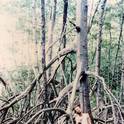
Article
Can they dig it? Functional morphology and degrees of semifossoriality among some American shrews (Mammalia, Soricidae).
Journal of Morphology
(2014)
Abstract
Small-eared shrews (Mammalia: Soricidae: Cryptotis), exhibit modifications of the forelimb skeleton that have been interpreted as adaptations for semifossoriality. Most species inhabit remote regions, however, and their locomotory and foraging behaviors remain mostly speculative. To better understand the morphological modifications in the absence of direct observations, we quantified variation in these species by measuring 151 individuals representing 18 species and populations of Cryptotis and two species of moles (Talpidae) for comparison. From our measurements, we calculated 22 indices, most of which have been used previously to characterize substrate use among rodents and other taxa. We analyzed the indices using 1) average percentile ranks, 2) principal components analysis, and 3) cluster analysis. From these analyses, we determined that three basic modes of substrate adaptation are present within Cryptotis: 1) a primarily terrestrial mode, with species that are capable of burrowing, but lack adaptations to increase digging efficiency, 2) a semifossorial mode, with species whose forelimbs bones show strong muscle attachment areas and increased mechanical advantage, and 3) an intermediate mode. In addition to identifying new morphological characters and contributing to our understanding of the functional morphology of soricids, these analyses provide additional insight into the ecology of the species of interest.
Keywords
- burrowing; Eulipotyphla; fossoriality;insectivora; Neurotrichus; Soricomorpha; Talpidae; Uropsilus
Disciplines
Publication Date
2014
Citation Information
Neal Woodman and Sarah A. Gaffney. "Can they dig it? Functional morphology and degrees of semifossoriality among some American shrews (Mammalia, Soricidae)." Journal of Morphology (2014) Available at: http://works.bepress.com/nw/23/
